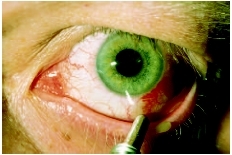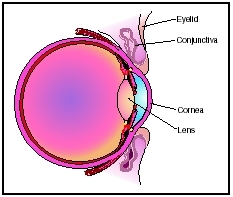Conjunctivitis
Definition
Conjuctivitis is an inflammation resulting in redness of the lining of the white part of the eye and the underside of the eyelid (conjunctiva) that can be caused by infection, allergic reaction, or physical agents like infrared or ultraviolet light.
Description
Conjunctivitis is the inflammation of the conjunctiva, a thin, delicate membrane that covers the eyeball and lines the eyelid. Conjunctivitis is an extremely common eye disease because the conjunctiva is continually exposed to microorganisms and environmental agents that can cause infections or allergic reactions. Conjunctivitis can be acute or chronic depending on how long the condition lasts, the severity of symptoms, and the type of organism or agent involved. It can affect one or both eyes and, if caused by infection, can be very easily transmitted to others during close physical contact, particularly among children in a school or daycare setting. Other names for conjunctivitis include pink eye and red eye.
Demographics
Conjunctivitis is the most common eye infection of childhood. It occurs so frequently that records are not kept, so exact demographic information has not been amassed.
Causes and symptoms
Conjunctivitis may be caused by a viral infection, such as a cold; acute respiratory infection; or other disease such as measles, herpes simplex , or herpes zoster. Symptoms include mild to severe discomfort in one or both eyes; redness; swelling of the eyelids; and watery, yellow, or green discharge. Symptoms may last anywhere from several days to two weeks. Infection with an adenovirus, however, may also cause a significant amount of pus-like discharge and a scratchy, foreign-body-sensation in the eye. These symptoms may be accompanied by swelling and tenderness of the lymph nodes near the ear.
Bacterial conjunctivitis can occur in adults and children and is caused by organisms such as Staphylococcus, Streptococcus , and Hemophilus . Symptoms of bacterial conjunctivitis include a pus-like discharge and crusty eyelids after awakening. Redness of the conjunctiva can be mild to severe and may be accompanied by swelling.

Conjunctivitis may also be caused by environmental hazards, such as wind, smoke, dust, and allergic reactions caused by pollen, dust, or grass. Symptoms range from itching and redness to a mucus discharge. Persons who wear contact lenses may develop allergic conjunctivitis caused by various eye solutions used and the foreign proteins contained in them.
Other less common causes of conjunctivitis include exposureto sun lamps or the electrical arcs used during welding and problems with inadequate drainage of the tear ducts.
Diagnosis
An accurate diagnosis of conjunctivitis centers on taking a patient's history to learn what symptoms are being experienced, when symptoms began, and other predisposing factors, such as upper respiratory complaints, allergies, sexually transmitted diseases , herpes simplex infections, and exposure to persons with pink eye. It may be helpful to learn whether an aspect of an individual's occupation may be the cause, for example, welding. Diagnostic tests are usually not indicated unless initial treatment fails or an infection with gonorrhea or chlamydia is suspected. In such cases, the discharge may be cultured and tested to determine the organism responsible for causing the condition.
Treatment
The treatment of conjunctivitis depends on what caused the condition. In all cases, warm compresses

Conjunctivitis due to a viral infection, particularly those due to adenoviruses, are usually treated by applying warm compresses to the affected area and using topical antibiotic ointments to prevent secondary bacterial infections.
Viral conjunctivitis caused by herpes simplex should be referred to an ophthalmologist. Topical steroids are commonly prescribed in combination with antiviral therapy.
In cases of bacterial conjunctivitis, a physician may prescribe an antibiotic eye ointment or eye drops containing sodium sulfacetamide (Sulamyd) to be applied daily for seven to 14 days. If, after 72 hours, the condition does not improve, a physician or primary care provider should be notified, because the bacteria involved may be resistant to the antibiotic used or the cause may not be bacterial.
For cases of conjunctivitis caused by a gonococcal organism, a physician may prescribe an intramuscular injection of ceftriaxone (Rocephin) and a topical antibiotic ointment containing erythromycin or bactracin to be applied four times daily for two to three weeks. Sexual partners should also be treated.
With accompanying chlamydia infection, a topical antibiotic ointment containing erythromycin (Ilotycin) may be prescribed to be applied one to two times daily. In addition, oral erythromycin or tetracycline therapy may be indicated for three to four weeks. Again, sexual partners should also be treated.
Allergic conjunctivitis can be treated by removing the allergic substance from a person's environment, if possible; by applying cool compresses to the eye; and by administering eye drops four to six times daily for four days. Also, the antihistamine diphenhydramine hydrochloride (Benadryl) may help to relieve itchy eyes.
Prognosis
If treated properly, the prognosis for conjunctivitis is good. Conjunctivitis caused by an allergic reaction should clear up once the allergen is removed. However, allergic conjunctivitis will likely recur if the individual again comes into contact with the particular allergen. Conjunctivitis caused by bacteria or a virus, if treated properly, is usually resolved in ten to 14 days. If there is no relief of symptoms in 48 to 72 hours, or there is moderate to severe eye pain , changes in vision, or the conjunctivitis is suspected to be caused by herpes simplex, a physician should be notified immediately. If untreated or if treatment fails and is not corrected, conjunctivitis may cause visual impairment by spreading to other parts of the eye, such as the cornea.
Prevention
Conjunctivitis can, in many cases, be prevented, or at least the course of the disease can be shortened by following these simple practices:
- frequently washing hands with antiseptic soap and using single-use towels while the disease continues
- avoiding chemical irritants and known allergens
- in an area where welding occurs, using the proper protective eye wear and screens to prevent damaging the eyes
- using a clean tissue to remove discharge from eyes and washing hands to prevent the spread of infection
- if medication is prescribed, finishing the course of antibiotics , as directed, to make sure that the infection is cleared up and does not recur
- avoiding close contact, such as vigorous physical activities, with other persons until symptoms resolve
KEY TERMS
Adenovirus —A type of virus that can cause upper respiratory tract infections.
Chlamydia —The most common bacterial sexually transmitted disease in the United States. It often accompanies gonorrhea and is known for its lack of evident symptoms in the majority of women.
Gonococcal —Refers to the bacterium Neisseria gonorrheae . This bacterium causes gonorrhea, a sexually transmitted infection of the genitals and urinary tract. The gonococcal organism may occasionally affect the eye, causing blindness if not treated.
Herpes simplex virus —A virus that can cause fever and blistering on the skin and mucous membranes. Herpes simplex 1 infections usually occur on the face (cold sores) and herpes simplex 2 infections usually occur in the genital region.
Herpes zoster virus —Acute inflammatory virus that attacks the nerve cells on the root of each spinal nerve with skin eruptions along a sensory nerve ending. It causes chickenpox and shingles. Also called varicella zoster virus.
Staphylococcus —Any of several species of spherical bacteria that occur in groups of four or in irregular clusters. They can infect various parts of the body, especially the skin and mucous membranes.
Streptococcus —Plural, streptococci. Any of several species of spherical bacteria that form pairs or chains. They cause a wide variety of infections including scarlet fever, tonsillitis, and pneumonia.
Resources
BOOKS
"Disorder of the Conjunctiva." In Nelson Textbook of Pediatrics. Edited by Richard E. Behrman et al. Philadelphia: Saunders, 2004.
Weiss, Avery H. "Conjunctivitis Beyond the Neonatal Period." In Principles and Practice of Pediatric Infectious Diseases , 2nd ed. Edited by Sarah S. Long et al. St. Louis, MO: Elsevier, 2003.
WEB SITES
Silverman, Michael A., et al. "Conjunctivitis." eMedicine , October 12, 2004. Available online at http://www.emedicine.com/emerg/topic110.htm (accessed December 25, 2004).
Lisa Papp, RN Rosalyn Carson-DeWitt, MD
Comment about this article, ask questions, or add new information about this topic: